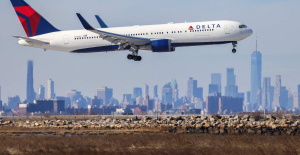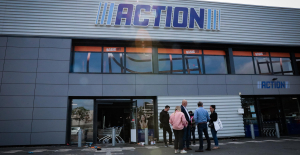It's 10 a.m. in Westborough, a town 25 miles from Boston, Massachusetts, and Amazon's BOS27 is fully operational. In these facilities there are no packages that come and go, nor large shelves of products of all kinds, since it is a robotics center, that is, the cradle where the electronic commerce giant manufactures the robots that will later handle the packages that arrive to the consumer.
And it is that, since the company opened this center in 2021, adding to another one also located in the same state, Amazon makes it clear that the future of its logistics centers go through the application of robotics. "This journey started 10 years ago and we're proud, but what we're going to do in the next five years is going to be so much more amazing. Computer learning and factory process automation are now our goals." Joe Quinlivan, Amazon's vice president of Robotics, Fulfillment and IT, assured journalists from around the world that Amazon convened at BOS27 a few days ago.
The company has established its two robot factories (North Reading and BOS27) in Massachusetts, and not by chance. The North American state is the place of origin of Kiva Systems, a robotics company that Amazon bought for 775 million in 2012 and based on which it has built the current Amazon Robotics. This state is also from iRobot, a company that the American company acquired this summer for 1.7 billion dollars, and the MIT, Massachusetts Institute of Technology is also located here. If you're looking for robotics talent, Boston is 'the place to be', according to experts. And Amazon's top managers corroborate it. "We are in the center of the robotics universe, here in Massachusetts. 350,000 feet (about 32,500 square meters) where we test all the robots that Amazon will later use in its centers and where we do the pertinent quality tests. Here we are manufacturing the machines of the future," said Tye Brady, Chief Technology Officer at Amazon Robotics.
Specifically, between the North Reading center and the Westborough center, the company has 10 robot production lines of which approximately 1,000 come out per day, a total of 330,000 per year, making it the largest manufacturer of industrial robots in the world. About 400 workers work between both factories. "At the moment it is humans who assemble the robots and it will continue to be so, although we explore new technologies," explained Erika McClosky, director of manufacturing at Amazon Robotics, on the production line.
In fact, among all the robots capable of classifying products, raising and lowering large shelves of items or even drones capable of delivering packages (see support), human labor seems essential, or so they say from Amazon.
John Maynard Keynes predicted in 1993 that widespread technological unemployment was coming due to the discovery of means to save labor, such as robotics. At Amazon they cling to the opposite idea. "We made our first serious investment in robotics over 10 years ago and in those 10 years we have created over a million jobs. In addition, we have created 700 new job categories and currently 75% of the 13 million packages that delivered daily to users in their homes are handled by some robotic system," adds Quinlivan. The figure could touch 100% in the next 5 years.
To encourage employment, and in support of this robotics job creation, Amazon has invested in programs like Career Choice and the Mechatronics and Robotics Apprenticeship Program to retrain people in high-demand fields like robotics and robotics. Software Engineering. Specifically, the mechatronics and robotics learning program was launched in 2020 and has more than 1,400 graduates. Amazon covers the cost of the 12-week classroom, 2,000-hour on-the-job training program to help employees learn new skills and perform in-demand technical maintenance roles. Once the apprenticeship is completed, the salary of the employees increases by approximately 40%, they say.
"Jobs are not lost, they are created and transformed. Men and machines are working together because progress cannot be made without employees. Both are needed to be efficient. Jobs will not be eliminated by robotics," insists the head of Technology at Amazon Robotics.
Amazon's commitment to robotics responds to an attempt by the company to cut costs in the home delivery segment. The current crisis and the situation of uncertainty also touch the American giant, which in its latest accounts ensured that consumer spending was in unknown waters and lowered revenue forecasts below what was expected on Wall Street. In fact, the company is reducing its spending on logistics and has suspended projects for centers around the world, including Spain. In addition, this week the giant has announced the dismissal of 10,000 employees, 1% of the workforce, mainly in the Alexa manufacturing, sales and human resources departments.

 B:SM will break its investment record this year with 62 million euros
B:SM will break its investment record this year with 62 million euros War in Ukraine: when kyiv attacks Russia with inflatable balloons loaded with explosives
War in Ukraine: when kyiv attacks Russia with inflatable balloons loaded with explosives United States: divided on the question of presidential immunity, the Supreme Court offers respite to Trump
United States: divided on the question of presidential immunity, the Supreme Court offers respite to Trump Maurizio Molinari: “the Scurati affair, a European injury”
Maurizio Molinari: “the Scurati affair, a European injury” Beware of the three main sources of poisoning in children
Beware of the three main sources of poisoning in children First three cases of “native” cholera confirmed in Mayotte
First three cases of “native” cholera confirmed in Mayotte Meningitis: compulsory vaccination for babies will be extended in 2025
Meningitis: compulsory vaccination for babies will be extended in 2025 Spain is the country in the European Union with the most overqualified workers for their jobs
Spain is the country in the European Union with the most overqualified workers for their jobs In the United States, a Boeing 767 loses its emergency slide shortly after takeoff
In the United States, a Boeing 767 loses its emergency slide shortly after takeoff The A13 motorway will not reopen on May 1
The A13 motorway will not reopen on May 1 More than 1,500 items for less than 1 euro: the Dutch discounter Action opens a third store in Paris
More than 1,500 items for less than 1 euro: the Dutch discounter Action opens a third store in Paris 100 million euros in loans, water storage, Ecophyto plan… New measures from the executive towards farmers
100 million euros in loans, water storage, Ecophyto plan… New measures from the executive towards farmers New York justice returns 30 works of art looted from Cambodia and Indonesia
New York justice returns 30 works of art looted from Cambodia and Indonesia Les Galons de la BD dedicates War Photographers, a virtuoso album on the Spanish War
Les Galons de la BD dedicates War Photographers, a virtuoso album on the Spanish War Theater: Kevin, or the example of an academic failure
Theater: Kevin, or the example of an academic failure The eye of the INA: Jean Carmet, the thirst for life of a great actor
The eye of the INA: Jean Carmet, the thirst for life of a great actor Skoda Kodiaq 2024: a 'beast' plug-in hybrid SUV
Skoda Kodiaq 2024: a 'beast' plug-in hybrid SUV Tesla launches a new Model Y with 600 km of autonomy at a "more accessible price"
Tesla launches a new Model Y with 600 km of autonomy at a "more accessible price" The 10 best-selling cars in March 2024 in Spain: sales fall due to Easter
The 10 best-selling cars in March 2024 in Spain: sales fall due to Easter A private jet company buys more than 100 flying cars
A private jet company buys more than 100 flying cars This is how housing prices have changed in Spain in the last decade
This is how housing prices have changed in Spain in the last decade The home mortgage firm drops 10% in January and interest soars to 3.46%
The home mortgage firm drops 10% in January and interest soars to 3.46% The jewel of the Rocío de Nagüeles urbanization: a dream villa in Marbella
The jewel of the Rocío de Nagüeles urbanization: a dream villa in Marbella Rental prices grow by 7.3% in February: where does it go up and where does it go down?
Rental prices grow by 7.3% in February: where does it go up and where does it go down? Even on a mission for NATO, the Charles-de-Gaulle remains under French control, Lecornu responds to Mélenchon
Even on a mission for NATO, the Charles-de-Gaulle remains under French control, Lecornu responds to Mélenchon “Deadly Europe”, “economic decline”, immigration… What to remember from Emmanuel Macron’s speech at the Sorbonne
“Deadly Europe”, “economic decline”, immigration… What to remember from Emmanuel Macron’s speech at the Sorbonne Sale of Biogaran: The Republicans write to Emmanuel Macron
Sale of Biogaran: The Republicans write to Emmanuel Macron Europeans: “All those who claim that we don’t need Europe are liars”, criticizes Bayrou
Europeans: “All those who claim that we don’t need Europe are liars”, criticizes Bayrou These French cities that will boycott the World Cup in Qatar
These French cities that will boycott the World Cup in Qatar Tennis: “I need to regain confidence in my body,” explains Rafael Nadal
Tennis: “I need to regain confidence in my body,” explains Rafael Nadal NBA: Orlando returns to level with Cleveland in the 1st round of the play-offs
NBA: Orlando returns to level with Cleveland in the 1st round of the play-offs Tennis: Iga Swiatek in the round of 16 at full speed
Tennis: Iga Swiatek in the round of 16 at full speed “It was exceptional here in Chaban-Delmas”: Escudero looks back on the excitement around France-England
“It was exceptional here in Chaban-Delmas”: Escudero looks back on the excitement around France-England

















